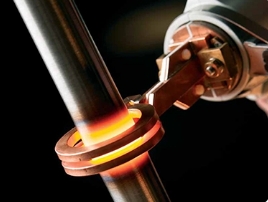- 04
- Dec
After the induction hardened parts have completed the quenching process, what items are generally inspected?
After the induction hardened parts have completed the quenching process, what items are generally inspected?
(1) Appearance quality
The appearance quality of the quenched surface of the parts shall not have defects such as fusion, cracks, etc. The normally quenched surface is off-white with black (oxidized). Grayish white generally indicates that the quenching temperature is too high; all black or blue on the surface generally indicates that the quenching temperature is not enough. Local melting and obvious cracks, avalanches, and corners can be found during visual inspection. The appearance inspection rate of parts produced in small batches and batches is 100%.
(2) Hardness
Rockwell hardness tester can be used for random inspection. The sampling rate is determined according to the importance of the parts and process stability, generally 3% to 10%, supplemented by file inspection or 100% file inspection. During file inspection, it is best for the inspector to prepare standard hardness blocks of different hardness for comparison, so as to improve the accuracy of file inspection. In the conditional automated production, the more advanced hardness inspection method has adopted the eddy current tester and other assembly lines to inspect piece by piece.
(3) Hardened area
For partially quenched parts, it is necessary to check the size and position of the quenched area. Small batch production often uses a ruler or caliper to measure, and strong acid can also be used to corrode the quenched surface to make it appear white hardened area for inspection. The etching method is often used for adjustment tests. In mass production, if the inductor or the quenching control mechanism is reliable, generally only random inspections are performed, and the sampling rate is 1% to 3%.
(4) Depth of hardened layer
The depth of the hardened layer is currently mostly inspected by cutting hardened parts to measure the depth of the hardened layer. So far, the metallographic method has been used in the past to measure the depth of the hardened layer in the past, and GB 5617-85 will be implemented in the future to determine its depth by measuring the section hardness of the hardened layer. The depth inspection of the hardened layer requires damage to the parts. Therefore, in addition to special parts and special regulations, only random inspections are generally used. Large-scale production of small parts can be spot-checked for one piece per shift or one piece for every small number of workpieces produced, and one piece for large-scale parts can be spot-checked every month. When using advanced non-destructive testing equipment, the sampling rate can be increased, and even 100% can be used. For example, if the surface of the workpiece allows the Leeb hardness tester to indent, then it can be checked piece by piece with the Leeb hardness tester.
(5) Deformation and deflection
Deformation and deflection are mainly used to check shaft parts. Generally, a center frame and a dial indicator are used to measure the swing difference or deflection of the parts after quenching. The pendulum difference varies according to the length and aspect ratio of the part. The induction hardened part can be straightened, and its deflection can be slightly larger. Generally, the allowable pendulum difference is related to the grinding amount after quenching. The smaller the grinding amount, the smaller the allowable pendulum difference. The diameter grinding allowance of general shaft parts is usually 0.4~1mm. The pendulum difference after the parts are allowed to be straightened is 0.15~0.3mm.
(6) Crack
The more important parts need to be inspected by magnetic particle inspection after quenching, and factories with better equipment have used phosphors to show cracks. Parts that have been magnetically inspected should be demagnetized before being sent to the next process.

